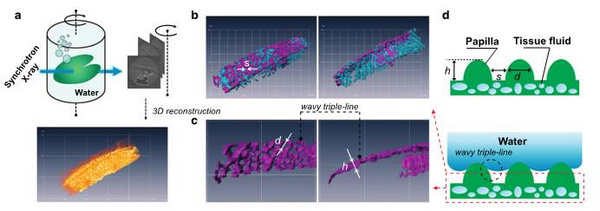Superhydrophobicity is an important phenomenon in nature that inspires the design of numerous biomimetic functional materials. A superhydrophobic surface is expected to have a three-phase solid–liquid-vapor interface. To directly image the buried air phase in wetted superhydrophobic surfaces, researchers from SINAP and South China University of Technology employed synchrotron radiation-based X-ray phase-contrast imaging to non-invasively probe the surfaces of natural lotus leaves and artificial carbon nanotube films in three dimensions. Reconstructed images of the three-phase distribution surrounding the superhydrophobic surfaces were presented with high resolution and contrast. Further extraction of the phases enabled direct analysis of the relationship between the surface morphology and its wetting property. They found that the protruding micro/nano-structures trapped a layer of air up to 14 μm thick, which played an important role in the observed superhydrophobicity. Direct evidence of the presence of a buffer layer air cushion deepens our understanding of hydrophobicity and opens new opportunities for designing novel bioinspired materials. The work has been published in?NPG Asia Materials (2016) 8, e306; doi:10.1038/am.2016.122


